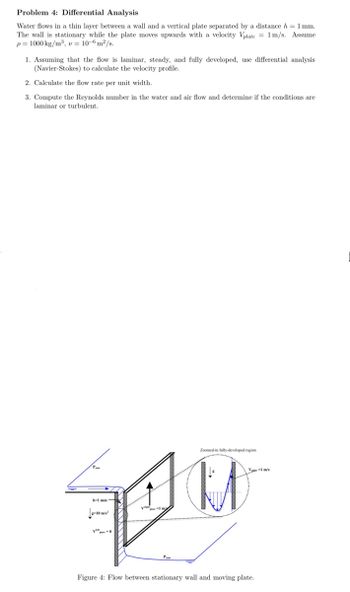
Elements Of Electromagnetics
7th Edition
ISBN: 9780190698614
Author: Sadiku, Matthew N. O.
Publisher: Oxford University Press
expand_more
expand_more
format_list_bulleted
Question

Transcribed Image Text:Problem 4: Differential Analysis
Water flows in a thin layer between a wall and a vertical plate separated by a distance h = 1 mm.
The wall is stationary while the plate moves upwards with a velocity Vplate = 1 m/s. Assume
p=1000 kg/m³, v = 10-6 m²/s.
1. Assuming that the flow is laminar, steady, and fully developed, use differential analysis
(Navier-Stokes) to calculate the velocity profile.
2. Calculate the flow rate per unit width.
3. Compute the Reynolds number in the water and air flow and determine if the conditions are
laminar or turbulent.
b-1 mm
g-10
Pam
Zoomed-in fully-developed region
V-1 m/s
Figure 4: Flow between stationary wall and moving plate.
Expert Solution
This question has been solved!
Explore an expertly crafted, step-by-step solution for a thorough understanding of key concepts.
This is a popular solution
Trending nowThis is a popular solution!
Step by stepSolved in 2 steps with 3 images

Knowledge Booster
Similar questions
- K = 1.4*10-4arrow_forwardliquid (density 800kg/m3, viscosity 10−3 kg/ms) has to be supplied at a mean speed of 2m/s through a pipe of diameter 12.5mm with a surface roughness equivalent to that for structural steel. What is the magnitude of the pressure gradient necessary to achieve this flow? Your answer should have a positive sign and be to the nearest 10 Pa/m. You may wish to use the Moody diagram.arrow_forwardProblem s): Consider incompressible Newtonian fluid flow between parallel plates (Fig. 7) that are horizontal and a distance A apart. A constant pressure gradient is applied in the x-direction (dp/dx). The flow is fully developed laminar and steady. The plate width is denoted by B. a) Simplify the governing equations TILST b) Define the boundary conditions inte c) Determine the velocity profile Continuity Equation f + P8x P8y ə əx Momentum Equations au 2x² Pgz (pu) + др əx + μl ap + M ay (pv) + 2- (07) - = əz ap + az d²v əx² a²w 2 dx² + + + อิน dy² dv dy² a²w ay² + + a²u ลิน az + a²w az² ди pl at dv at dw at + u + 11 + u ди əx dv əx aw əx + v + v ди + v ду dv ду + w dw + w du Fig. 7: Flow between parallel plates with a constant pressure gradient az du + w əz dw az Fixed 1 1 1 u(y) Fixed max Aarrow_forward
- 6) Air flow though the device shown in figure. Select which set of the following conditions is TRUE assuming incompressible non-viscous steady flow (a) p4 v3 (c) p2>p3; v2 > v3 (e) p4> pl; v4 pl; v1 > v3 (d) p4 vl "OUTarrow_forwardAn incompressible viscous flow is contained between two parallel plates separated from each other by distance b. as shown in Figure 1. The flow is caused by the movement of the upper plate which has a velocity U, while the bottom plate is fixed. If U =7 m/s and b= 1 cm, and there is no pressure gradient in the flow direction. A.) Start with Navier-Stokes equations and determine the velocity at the point x = 3 cm and y= 0.41 cm. The value of the velocity is.B.) Calculate the magnitude of the vorticity at the same point. The magnitude value of vorticity. C.) Calculate the rate of angular deformation at the same point. The angular deformation valuearrow_forwardOil Coating: A long, continuous belt is pulled upwards through a chemical oil bath at velocity V0. The belt has rectangular cross-section and has length (L), width into the paper (W). The belt picks up a film of oil of thickness h, density ρ, and dynamic viscosity μ. Gravity g tends to make the oil drain down, but the movement of the belt keeps the fluid from running off completely. Assume fully developed, steady, laminar, incompressible and two-dimensional flow of oil to answer the following questions. Assume that no pressure gradient is needed in the vertical direction to drive the film flow. Also assume that the shear stress at the air-oil interface is zero (free shear condition). Assume no-slip condition for the fluid in contact with the moving belt. Justify any other assumptions you may make. Show all steps. (a) Derive an expression for the two-dimensional velocity field inside the oil film in terms of the known parameters. Clearly indicate your co-ordinates and origin. You must…arrow_forward
arrow_back_ios
arrow_forward_ios
Recommended textbooks for you
 Elements Of ElectromagneticsMechanical EngineeringISBN:9780190698614Author:Sadiku, Matthew N. O.Publisher:Oxford University Press
Elements Of ElectromagneticsMechanical EngineeringISBN:9780190698614Author:Sadiku, Matthew N. O.Publisher:Oxford University Press Mechanics of Materials (10th Edition)Mechanical EngineeringISBN:9780134319650Author:Russell C. HibbelerPublisher:PEARSON
Mechanics of Materials (10th Edition)Mechanical EngineeringISBN:9780134319650Author:Russell C. HibbelerPublisher:PEARSON Thermodynamics: An Engineering ApproachMechanical EngineeringISBN:9781259822674Author:Yunus A. Cengel Dr., Michael A. BolesPublisher:McGraw-Hill Education
Thermodynamics: An Engineering ApproachMechanical EngineeringISBN:9781259822674Author:Yunus A. Cengel Dr., Michael A. BolesPublisher:McGraw-Hill Education Control Systems EngineeringMechanical EngineeringISBN:9781118170519Author:Norman S. NisePublisher:WILEY
Control Systems EngineeringMechanical EngineeringISBN:9781118170519Author:Norman S. NisePublisher:WILEY Mechanics of Materials (MindTap Course List)Mechanical EngineeringISBN:9781337093347Author:Barry J. Goodno, James M. GerePublisher:Cengage Learning
Mechanics of Materials (MindTap Course List)Mechanical EngineeringISBN:9781337093347Author:Barry J. Goodno, James M. GerePublisher:Cengage Learning Engineering Mechanics: StaticsMechanical EngineeringISBN:9781118807330Author:James L. Meriam, L. G. Kraige, J. N. BoltonPublisher:WILEY
Engineering Mechanics: StaticsMechanical EngineeringISBN:9781118807330Author:James L. Meriam, L. G. Kraige, J. N. BoltonPublisher:WILEY

Elements Of Electromagnetics
Mechanical Engineering
ISBN:9780190698614
Author:Sadiku, Matthew N. O.
Publisher:Oxford University Press

Mechanics of Materials (10th Edition)
Mechanical Engineering
ISBN:9780134319650
Author:Russell C. Hibbeler
Publisher:PEARSON

Thermodynamics: An Engineering Approach
Mechanical Engineering
ISBN:9781259822674
Author:Yunus A. Cengel Dr., Michael A. Boles
Publisher:McGraw-Hill Education

Control Systems Engineering
Mechanical Engineering
ISBN:9781118170519
Author:Norman S. Nise
Publisher:WILEY

Mechanics of Materials (MindTap Course List)
Mechanical Engineering
ISBN:9781337093347
Author:Barry J. Goodno, James M. Gere
Publisher:Cengage Learning

Engineering Mechanics: Statics
Mechanical Engineering
ISBN:9781118807330
Author:James L. Meriam, L. G. Kraige, J. N. Bolton
Publisher:WILEY